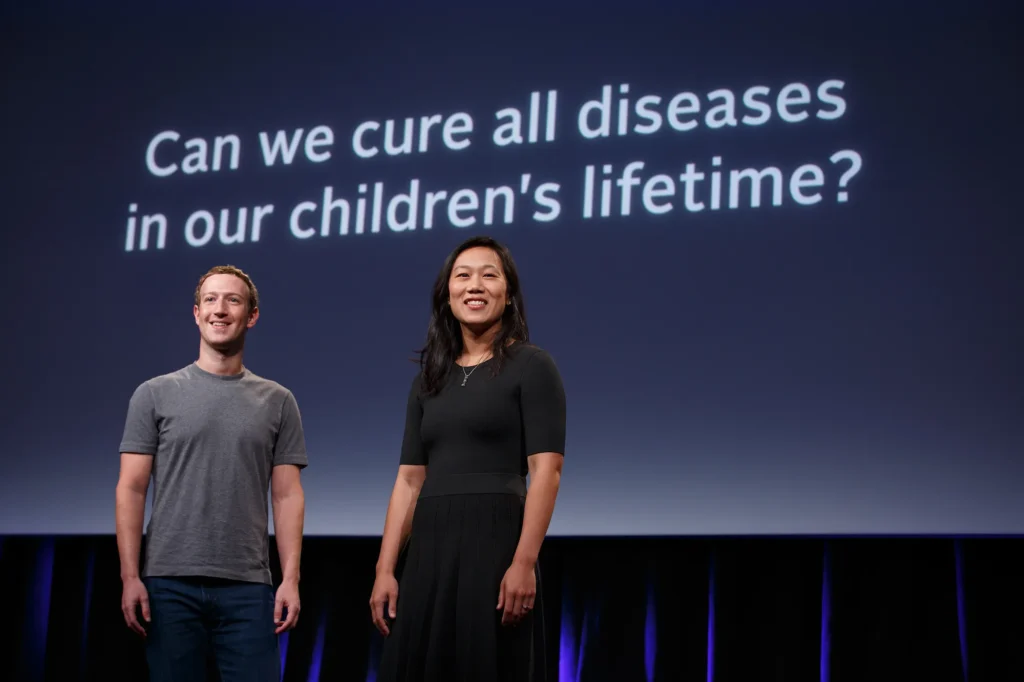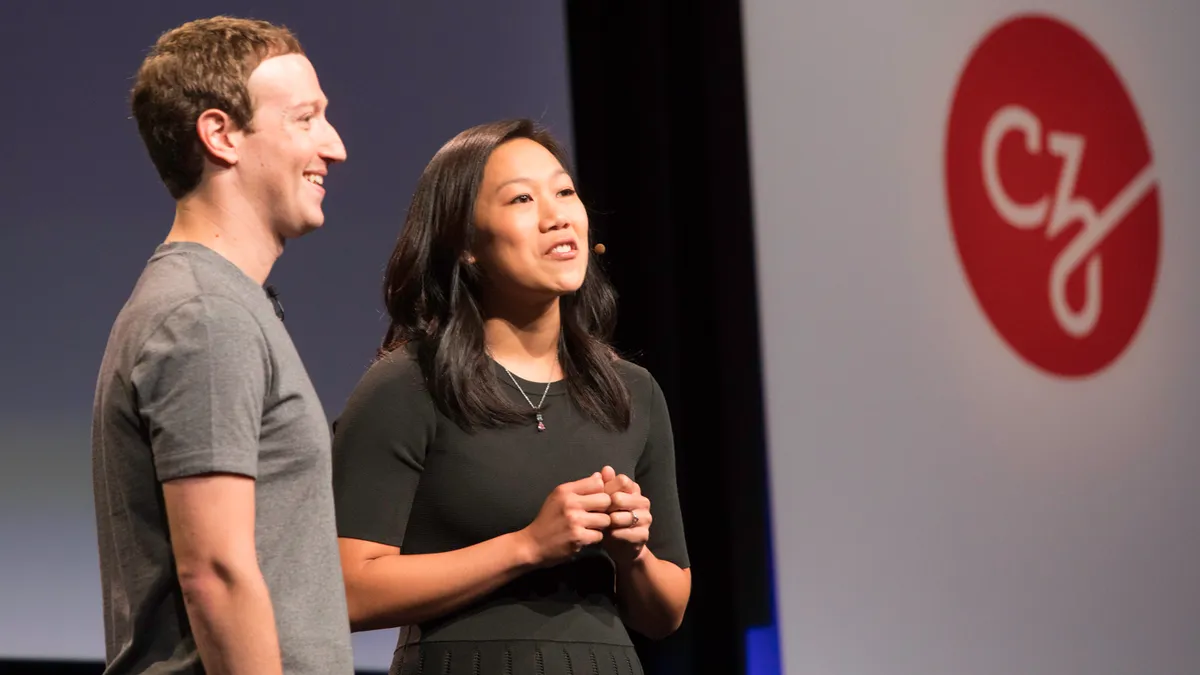Executive Summary: A Philanthropic Pledge with Profound Implications


In December 2015, Mark Zuckerberg, the co-founder and CEO of Facebook (now Meta Platforms), and his wife, Dr. Priscilla Chan, announced a significant commitment. They planned to donate 99% of their Facebook shares, valued at approximately $45 billion at the time, through a newly established entity: the Chan-Zuckerberg Initiative (CZI). This pledge, made in an open letter to their newborn daughter, Max, initially received praise for its scale and ambition. However, the subsequent scrutiny of the Chan-Zuckerberg Initiative‘s structure as a Limited Liability Company (LLC) instead of a traditional charitable foundation sparked debate. This report provides an in-depth analysis of the Chan-Zuckerberg Initiative. It examines the initiative’s structure, mission, evolution, impact on Meta, the diverse reactions it has elicited, its position within tech philanthropy, and the long-term implications for Zuckerberg, Meta, and the world of philanthropy.
The Landmark Announcement: Zuckerberg’s Commitment and the Birth of the Chan-Zuckerberg Initiative
The announcement of Mark Zuckerberg and Priscilla Chan’s philanthropic commitment occurred on December 1, 2015. They shared their plans through an open letter addressed to their newborn daughter, Max. This personal touch highlighted the couple’s desire to create a better world for future generations. The pledge involved 99% of their Facebook shares, then valued at around $45 billion. This substantial donation would be distributed over their lifetimes, not transferred immediately. On the same day, a filing with the U.S. Securities and Exchange Commission (SEC) revealed Zuckerberg’s intention to sell or gift no more than $1 billion of Facebook stock annually for the next three years. This suggested a measured approach to wealth distribution. It likely aimed to minimize impact on Facebook’s stock value and allow sustained involvement in the initiative’s direction. The timing of this announcement, coinciding with their first child’s birth, added a sense of personal legacy and commitment to shaping a positive future for their daughter and all children. The planned, gradual transfer of such a large sum indicated a long-term vision for their philanthropic endeavors. It also showed a desire to maintain influence over how these funds would be used to achieve their goals through the Chan-Zuckerberg Initiative.
What Led to the birth of Chan-Zuckerberg Initiative
The motivations behind Mark Zuckerberg and Priscilla Chan’s decision to commit most of their wealth to philanthropic causes were outlined in their open letter. Their primary stated aim was “to advance human potential and promote equality for all children in the next generation”. To achieve this broad objective through the Chan-Zuckerberg Initiative, they initially focused on personalized learning, curing disease, connecting people, and building strong communities. This selection of focus areas reflected a comprehensive vision for societal improvement. Zuckerberg also highlighted a strategic rationale for their chosen structure. He mentioned that using an LLC would provide greater flexibility in executing their mission more effectively within the Chan-Zuckerberg Initiative. This suggested a desire to not only donate to existing charities but also to potentially invest in for-profit ventures and engage in policy advocacy. The inspiration for this significant pledge was deeply rooted in the couple’s desire to make the world better for their daughter’s generation, reflecting a personal commitment to long-term positive change via the Chan-Zuckerberg Initiative.
Initial Areas of Focus for Chan-Zuckerberg Initiative
The initial areas of focus for the Chan-Zuckerberg Initiative were ambitious and wide-ranging. They signaled a commitment to tackling significant global challenges across various sectors. Personalized learning was a key area. It reflected a belief in technology’s potential to tailor education to individual student needs. The goal was to use innovative tools to ensure every child could reach their full potential through education, supported by the Chan-Zuckerberg Initiative. Curing disease was another paramount focus of the Chan-Zuckerberg Initiative. It demonstrated a long-term vision to advance biomedical research to eradicate, prevent, or manage all diseases by the end of the century. This ambitious goal signaled a commitment to investing in scientific breakthroughs and fostering collaboration within the research community through the Chan-Zuckerberg Initiative. Connecting people aimed to leverage technology to bridge divides and foster understanding globally. This focus likely stemmed from Zuckerberg’s experience with Facebook. Finally, building strong communities highlighted the importance of fostering social cohesion and addressing local needs to create supportive environments, an aim of the Chan-Zuckerberg Initiative. These initial areas, while broad, laid the foundation for the Chan-Zuckerberg Initiative‘s early work.
Deconstructing the Chan-Zuckerberg Initiative: Structure, Mission, and Evolution
The strategic choice to structure the Chan-Zuckerberg Initiative as a Limited Liability Company (LLC) instead of a traditional 501(c)(3) non-profit organization was deliberate. It offered potential benefits but also sparked controversy. This unconventional structure for such a large philanthropic endeavor provided greater flexibility in pursuing the Chan-Zuckerberg Initiative‘s mission. Unlike traditional foundations, an LLC can fund non-profits, make private investments in for-profit companies, and actively participate in policy debates. This allowed the Chan-Zuckerberg Initiative to adopt a broader range of strategies, including impact investing. Furthermore, the LLC structure enabled the Chan-Zuckerberg Initiative to engage in lobbying and make political donations, which are restricted for traditional charities. This offered a direct avenue for influencing public policy. Another advantage was the absence of a mandatory board, allowing Mark Zuckerberg and Priscilla Chan to retain full control over the Chan-Zuckerberg Initiative‘s direction. Additionally, LLCs generally face fewer reporting requirements and enjoy greater privacy than non-profits.
Controversies that revolved around Chan-Zuckerberg Initiative
Despite these advantages, structuring the Chan-Zuckerberg Initiative as an LLC sparked considerable controversy. A primary concern was the potential for minimizing taxes, although Mark Zuckerberg stated they received no tax benefits from transferring shares to the LLC. Nevertheless, skepticism persisted about potential long-term tax advantages. Another major point of contention was the perceived lack of transparency compared to charitable foundations. The absence of mandatory public reporting for LLCs raised concerns about how the vast funds of the Chan-Zuckerberg Initiative would be used. Some critics questioned whether the initiative represented genuine philanthropy. The ability of an LLC to engage in political lobbying also drew criticism, with concerns about undue influence. The debate surrounding the Chan-Zuckerberg Initiative‘s LLC structure highlighted the evolving landscape of philanthropy.
The Chan-Zuckerberg Initiative Mission
The stated mission of the Chan-Zuckerberg Initiative is “to build a more inclusive, just, and healthy future for everyone”. This overarching mission encompasses advancing human potential and promoting equality in health, education, scientific research, and energy. To achieve this, the Chan-Zuckerberg Initiative initially focused on science, education, and justice and opportunity. In science, a significant emphasis was placed on research aimed at curing, preventing, and managing all diseases by the end of the 21st century. This involved funding basic biomedical research and developing new scientific tools. In education, the Chan-Zuckerberg Initiative‘s goals centered on improving learning experiences for children. The justice and opportunity domain focused on promoting housing affordability and advancing criminal justice reform. Over time, the Chan-Zuckerberg Initiative has increasingly emphasized scientific advancements, particularly at the intersection of biology and artificial intelligence.
Scientific Investments from Chan-Zuckerberg Initiative
Over the years, the Chan-Zuckerberg Initiative has undertaken many programs. In science, a cornerstone has been the Chan Zuckerberg Science program, with a $3 billion investment over a decade. A significant focus has been on developing technologies to analyze human biology. This led to the Chan Zuckerberg Biohub Network, tackling scientific challenges. A prominent aspect of the Chan-Zuckerberg Initiative‘s science strategy has been the convergence of artificial intelligence and biology. This focus has been articulated through several scientific Grand Challenges, including building an AI-based virtual cell model.
In education, the Initiative has significantly supported personalized learning. This involved funding for education communities and teacher retention efforts. CZI also developed tools like Along.
Within justice and opportunity, the Initiative initially focused on housing affordability. It also funded criminal justice and immigration reform advocacy.
Beyond these areas, the Chan-Zuckerberg Initiative has invested in open science and supported COVID-19 research. It has also been involved in community support in the Bay Area.
The Chan-Zuckerberg Initiative has evolved strategically, with increasing emphasis on science and AI. This shift involved winding down social advocacy work. A key development was the integration of CZI and the Biohub Network under a unified science strategy. This refined focus is articulated through CZI’s commitment to four scientific Grand Challenges: building an AI-based virtual cell model, developing advanced imaging systems, creating tools for measuring inflammation, and engineering the immune system. The underlying belief is that AI and biology hold immense potential for scientific breakthroughs, a core tenet of the Chan-Zuckerberg Initiative‘s current direction.
The Intertwined Fate of Facebook/Meta and Zuckerberg’s Philanthropy
Mark Zuckerberg structured his decision to donate most of his wealth, primarily in Meta stock, to ensure it did not reduce his control within the company. Zuckerberg intended to retain a majority voting position in Meta stock. The transfer of shares to the Chan-Zuckerberg Initiative was designed to maintain his authority over these shares. Meta’s dual-class share structure enables this continued control. Class B shares, mostly owned by Zuckerberg, hold ten votes each, while public Class A shares have one vote per share. Even with the significant donation to the Chan-Zuckerberg Initiative, Zuckerberg retains substantial voting power, making him largely impervious to being ousted. This strategic structuring shows how founders can engage in large-scale philanthropy using company stock without losing leadership or corporate control.
The Shareholders Reaction
Shareholders and financial markets have had varied perspectives on Mark Zuckerberg’s philanthropic endeavors through the Chan-Zuckerberg Initiative. The initial announcement in 2015 generated positive publicity for Zuckerberg and Facebook. However, some shareholders have since voiced frustration with Meta’s management and scandals. Despite these concerns, the dual-class share structure limits shareholders’ influence over Zuckerberg’s actions, including his philanthropic choices via the Initiative. Meta’s business performance and Zuckerberg’s strategic decisions, like metaverse investments, are under scrutiny. While shareholders may appreciate the positive image philanthropy can create, their primary focus is on Meta’s financial health. Given Zuckerberg’s control, his personal decisions, including the Chan-Zuckerberg Initiative‘s direction, are not generally subject to direct shareholder oversight.
Meta Platforms, led by Mark Zuckerberg, emphasizes its mission of building community. Zuckerberg envisions the metaverse as the next stage of social connection. The Initiative is presented as a separate entity, co-founded with Priscilla Chan, with a broader mandate in health, education, and justice. While distinct, there is a connection between Meta’s image and Zuckerberg’s philanthropy through the Chan-Zuckerberg Initiative. Meta has faced criticism over privacy and misinformation. Zuckerberg’s philanthropic work through the Initiative can contribute to his and Meta’s public image and social responsibility efforts. By addressing global challenges, the Chan-Zuckerberg Initiative provides a counter-narrative to criticisms against Meta, potentially enhancing the social license of both in the long term.
A Polarized Response: Analyzing Reactions to the 99% Donation Pledge
The announcement of Mark Zuckerberg and Priscilla Chan’s pledge to donate 99% of their Facebook shares to the Chan-Zuckerberg Initiative in December 2015 elicited diverse reactions. Some lauded it as remarkable generosity, while others were skeptical about motives and methods, especially the LLC structure. Concerns arose about the lack of accountability compared to traditional non-profits. Some viewed the pledge cynically as a PR move. Nevertheless, figures like Warren Buffett congratulated the couple. Skepticism also lingered about potential tax benefits and Zuckerberg’s retained control over the donated assets within the Chan-Zuckerberg Initiative. This polarized response highlighted the complex dynamics of large-scale philanthropic announcements.
Core Arguments
The core arguments for and against the Chan-Zuckerberg Initiative, particularly its LLC structure and potential tax implications, reveal a fundamental debate about modern philanthropy. Arguments against often centered on the LLC structure allowing political spending with fewer restrictions than non-profits. Critics also pointed to the absence of mandatory annual payout requirements and the lack of public disclosure of finances for the Chan-Zuckerberg Initiative. A significant criticism suggested potential self-interest, arguing the initiative could primarily benefit Zuckerberg’s image and control while minimizing taxes. Some questioned the effectiveness of this “philanthrocapitalism” model.
The Response from Chan-Zuckerberg Initiative Supporters
In response to these concerns, Mark Zuckerberg and his supporters offered arguments favoring the Chan-Zuckerberg Initiative‘s structure and intentions. A key point was the LLC providing greater flexibility to pursue their mission beyond traditional grants. Zuckerberg stated they received no immediate tax benefit from transferring shares to the Chan-Zuckerberg Initiative. He emphasized their commitment to using any net profits to advance the initiative’s mission. The overall intention was to leverage the LLC’s flexibility to fund non-profits, make strategic investments, and participate in policy debates to generate positive impact. This debate highlighted the evolving understanding of philanthropy.
Over the long term, public perception and expert analysis of Mark Zuckerberg and Priscilla Chan’s philanthropic pledge to the Chan-Zuckerberg Initiative have evolved. There has been ongoing scrutiny of the initiative’s activities and effectiveness. Experts and the media have analyzed the impact of CZI’s funding on areas like education and science, with varying conclusions. Notably, debates continue about the effectiveness of personalized learning, a key focus of the Chan-Zuckerberg Initiative‘s early efforts. More recently, CZI’s shift towards science and AI has led to discontinued funding in areas like affordable housing, raising concerns. Additionally, the Chan-Zuckerberg Initiative has faced criticisms, including allegations of racial bias, further shaping public perception. Long-term analysis suggests that while the initial pledge drew attention, its sustained impact is still being evaluated.
The Chan-Zuckerberg Initiative in the Context of Tech Billionaire Philanthropy
The Chan-Zuckerberg Initiative operates within a broader landscape of significant philanthropic endeavors by technology billionaires. Comparing CZI’s approach, focus, and scale with organizations like the Bill & Melinda Gates Foundation, the Bezos Earth Fund, the Musk Foundation, and MacKenzie Scott’s giving provides valuable context.
Bill & Melinda Gates Foundation
The Bill & Melinda Gates Foundation primarily focuses on global health, poverty, and US education. Unlike the Chan-Zuckerberg Initiative‘s LLC structure, the Gates Foundation is a traditional charity known for strategic grantmaking and partnerships. There have been collaborations between the Gates Foundation and the Zuckerberg Initiative, particularly in education and science. However, the Gates Foundation has also faced criticisms regarding its influence and focus.
Bezos Earth Fund
The Bezos Earth Fund, established by Jeff Bezos, primarily focuses on combating climate change. Bezos has emphasized urgency and large-scale action. Unlike Zuckerberg, Bezos was initially a holdout on the Giving Pledge. The Bezos Earth Fund’s grantmaking sometimes includes unrestricted funding, similar to MacKenzie Scott.
The Musk Foundation, founded by Elon Musk, focuses on science, technology, and education, aligning with Musk’s interests. Musk’s philanthropy has faced criticism for being self-serving and lacking transparency. The Musk Foundation operates with a small team and less public disclosure than the Chan-Zuckerberg Initiative.
MacKenzie Scott is known for significant and rapid philanthropic giving focused on social justice through unrestricted grants. Her approach emphasizes trust in the supported organizations.
| Philanthropy | Founder(s) | Primary Focus Areas | Legal Structure | Transparency Level | Key Approaches | Collaborations |
| Chan-Zuckerberg Initiative | Mark Zuckerberg & Priscilla Chan | Science, Education, Justice | LLC | Moderate | Impact Investing, Grantmaking, Advocacy | Bill & Melinda Gates Foundation, Others |
| Bill & Melinda Gates Foundation | Bill & Melinda Gates | Global Health, Poverty, US Education | Foundation | High | Strategic Grantmaking, Partnerships | CZI, Others |
| Bezos Earth Fund | Jeff Bezos | Climate Change, Nature | Fund | Moderate | Large-scale Grants, Innovation | Others |
| Musk Foundation | Elon Musk | Science, Tech, Education | Foundation | Low | Self-serving Grants, Limited Disclosure | Limited Public Collaboration |
| MacKenzie Scott | MacKenzie Scott | Social Justice | Direct Giving | High | Unrestricted Grants, Trust-based Philanthropy | Others |
The Chan-Zuckerberg Initiative‘s LLC structure distinguishes it from the Gates Foundation. While both CZI and the Bezos Earth Fund are large-scale, their focus areas differ. The Musk Foundation has faced more scrutiny than the Zuckerberg Initiative. MacKenzie Scott’s trust-based approach contrasts with CZI’s more directed initiatives. Collaborations between the Chan-Zuckerberg Initiative and the Gates Foundation highlight potential synergies in philanthropy.
Navigating Controversy: Challenges and Criticisms Faced by the Chan-Zuckerberg Initiative
The Chan-Zuckerberg Initiative has faced challenges regarding the effectiveness and transparency of its programs. Questions have been raised about the impact of personalized learning initiatives. Concerns exist about the transparency of CZI’s grantmaking, given its LLC structure and use of donor-advised funds. Experts debate the long-term impact of CZI’s investments. Some critics argue that CZI’s early education reform efforts lacked sufficient community engagement.
A central controversy surrounding the Chan-Zuckerberg Initiative is its LLC structure. Critics persistently raise concerns about reduced regulatory burden and potential political influence. Despite Mark Zuckerberg’s denials of tax benefits, speculation about hidden advantages persists. The limited public accountability of an LLC remains a significant point of contention.
In addition to these debates, the Chan-Zuckerberg Initiative has faced specific criticisms. The discontinuation of DEI programs sparked concerns about inclusivity. Allegations of racial discrimination within the organization have also emerged. The closure of The Primary School campuses, citing lack of funding, has raised questions about long-term commitment to local education. These controversies, alongside past criticisms like the Newark schools donation, highlight the complex scrutiny of large-scale philanthropy.
Conclusion: Assessing the Long-Term Implications for Zuckerberg, Meta, and Philanthropy
The long-term implications of Mark Zuckerberg’s pledge and the Chan-Zuckerberg Initiative are multifaceted. The initiative has the potential for significant advancements in science and medicine, particularly in AI and biology. CZI’s adoption of the LLC structure has influenced philanthropic models. The initiative’s scale has contributed to debates about billionaire philanthropy’s role and accountability. While initially broad, CZI’s increasing focus on science and AI suggests a future trajectory in biomedical research.
Looking ahead, the Chan-Zuckerberg Initiative‘s influence will depend on achieving tangible results in science and AI. Increased transparency and engagement with critics may be necessary. Collaborations will be crucial. The Chan-Zuckerberg Initiative exemplifies the evolving role of billionaire philanthropy. The debate about its effectiveness and accountability remains critical. Ultimately, the Chan-Zuckerberg Initiative‘s long-term success will be measured by its scientific advancements and its ability to navigate ethical and operational considerations in private philanthropy.





